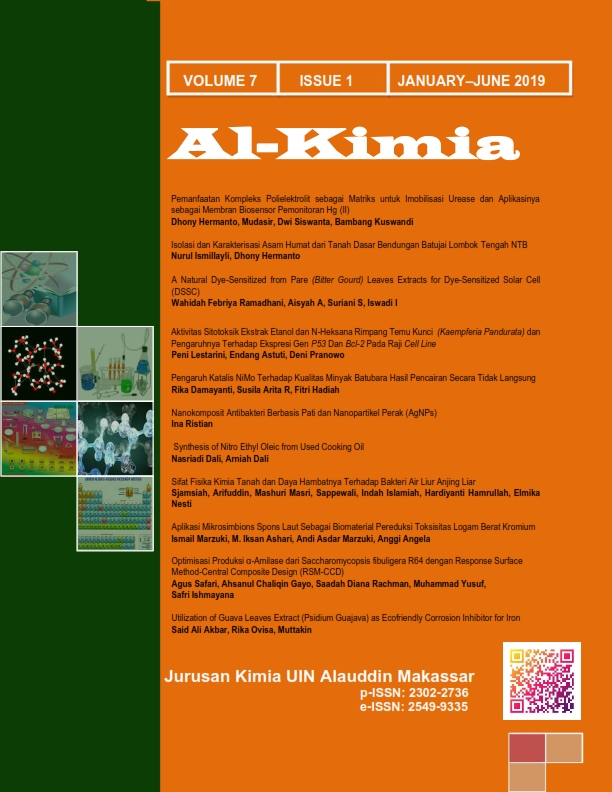Aplikasi Mikrosimbions Spons Laut Sebagai Biomaterial Pereduksi Toksisitas Logam Berat Kromium (Cr)
Abstrak
The vulnerable marine environment is polluted by various types of heavy metals due to human and natural activities. One of the marine biota sponges can carry out heavy metal adsorption functions, so the life of the sponge must be well maintained. The application of sponge micro symbiont adsorption method aims to reduce the toxicity of chromium metal. Absorption stage: culture isolates code Sp1, Sp2, Sp3, Petrosia sponge (Strongylophore) Corticata symbionts, phenotypic and genotypic characterization, suspension symbionts were formed, interacted with 100 ppm of 1: 1 ratio chromium solution Interaction time variation 5, 10, 15, 20, 25 days, extracted. The remaining non-reduced chromium was analyzed using AAS. Observation of reduction, gas, pH, optical density parameters. The results of phenotypic characterization showed that 3 sponge symbiont isolates reacted with lactose, catalase, MR, VP and citrate. Genotypes of Pseudomonas stutzeri isolates, strain Sp1 are RCH2, Sp2 code SLG510A3-8, and Sp3 code GLB197. The reduction parameters reached a contact period of 5-15 days, the performance of the symbionts in the reduction of chromium metal toxicity in the range of 62.34 ppm to 70.47 ppm was equivalent to the reduction rate of 60.16 to 69.09% concentration.
##plugins.generic.usageStats.downloads##
Referensi
Akinde, S.B., Iwuozor, C.C. and Obire, O, (2012). Alkane degradative potentials of bacteria isolate from the deep atlantic ocean of the Gulf of Guinea. Journal Bioremed Biodegradation, vol. 3 (1): 2-6
Alamri, A. S, (2012). Biodegradation of microcystin-RR by Bacillus flexus isolated from a Saudi freshwater lake. Published online- doi:10.1016/j .sjbs.2012.06.006. Saudi Journal Biol Sci, vol. 19 (4): 435-440
Ismet, S.M., Soedharma, D., Effendi, H., (2011). Morphology and cell biomass of sponge Aaptos aaptos and Petrosia sp., J. Ilmu Tek.Kelautan Tropis. vol. 3 (2): 153-161
Lydia, M., Alfian, N., Tjodi, H., Nicole, de, V., (2014). Essential Metal Zn in Sponge Callyspongia aerizusa from Spermonde Archipelago, Advances in Biological Chemistry Journal, vol. 4: 86-90, http://dx.doi.org/ 10.4236/abc,2014.41012
Marzuk, I., A. Noor, N. La Nafie, and Djide. N.M., (2015). Moleculer Characterization Of Gene 16S rRNA Microsymbionts In Sponge At Melawai Beach, East Kalimantan,” Marina Chimica. Acta, vol. 16 (1): 38–46, doi: 10.17605/OSF.IO/XKP9B
Marzuki, I., (2016). Analisis Kromium Heksavalen dan Nikel Terlarut dalam Limbah Cair Area Pertambangan PT. Vale Tbl, Soroako-Indonesia. Chemica, vol. 17 (2): 1–11. http://doi. org/view/4679/2685
Marzuki, I., Noor, A., Djide, N.M., La Nafie, N., (2014). Isolation and Identification on Degradator Bacterial of Petroleum waste which Symbionts with Sponge Callyspongis sp from Melawai Beach. Proceeding: International Confrence on the sciences (ICOS), 19-20 Nopember 2014, Makassar, ISBN: 9786027219809, vol. 1: 493-503, https://scholar.google.co.id/citations?View opiewcitation&hl=en&user=AjWcdX8AAJ, doi: 10.17605/OSF.IO/PZVKC.
Marzuki, I., Noor, A., Djide, N.M., La Nafie, N., (2016). Microsymbiont and Morphological Phenotype Analysis Marine Sponge Biomass from Melawai Beach, Balikpapan, East Kalimantan, Journal Marina Chimica Acta, vol. 17 (1): 8-15; https://scholar.google.co.id/citations?viewop= view_citation&hlAjWcdX8AAAAJ, doi: 10. 17605/OSF.IO/P73EN
Netty,S., Alfian, N., Nunuk, S., Nicole, de, V., (2014). A preliminary Effort to assign Sponge (Callyspongia sp) as trace metal biomonitor for Pb, Cd, Zn, and Cr, an enviromental persfective in hative gulf water Ambon, Advances in Biological Chemistry Journal, vol. 3: 549-552, http://dx.doi.org/10.4236/ abc, 2013.26062
Shama. S.A., M.E. Moustafa, M.A. Gad, (2010). Removal of heavy metals Fe3+, Cu2+, Zn2+, Pb2+, Cr3+ and Cd2+ From Aquaeus Solutins by Using Eichornia Crassipes, Journal Electrochimica Acta, vol. 28 (2) :125-133
Zhou, Y., Xia, S., Zhang, Z., Zhang, J., & Hermanowicz, S. W. (2011). Associated Adsorption Characteristics of Pb ( II ) and Zn ( II ) by a Novel Biosorbent Extracted from Waste-Activated Sludge. Environ. Eng, vol. (Ii), 1–7. https://doi.org/10.1061/(ASCE)EE.19 43-7870.0001104
Ziarati, P., Moshiri, I. M., & Sadeghi, P. (2017). Bio-adsorption of Heavy Metals from Aqueous Solutions by Natural and Modified non-living Roots of Wild Scorzonera incisa DC. Sci Discov, vol. 1 (99): 1–8. https:// doi.org/10.242 62/jsd.1.1.17010
##submission.copyrightStatement##
##submission.license.cc.by-nc-sa4.footer##Authors who publish with this journal agree to the following terms:
1) Authors retain copyright and grant the journal right of first publication with the work simultaneously licensed under a Creative Commons Attribution License that allows others to share the work with an acknowledgement of the work's authorship and initial publication in this journal.
2) Authors are able to enter into separate, additional contractual arrangements for the non-exclusive distribution of the journal's published version of the work (e.g., post it to an institutional repository or publish it in a book), with an acknowledgement of its initial publication in this journal.
3)Authors are permitted and encouraged to post their work online (e.g., in institutional repositories or on their website) prior to and during the submission process, as it can lead to productive exchanges, as well as earlier and greater citation of published work (See The Effect of Open Access).


